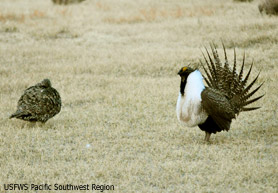The Greater Sage-Grouse
The Greater Sage-Grouse (Centrocercus urophasianus) is the largest North American grouse species and one of only two sage-grouse species in the world. The other sage-grouse species is the Gunnison Sage-Grouse (Centrocercus minimus).
Appearance
 Greater Sage-Grouse males are large ground-dwelling birds that have large white ruffs around their neck and bright yellow air sacs on their breasts. Females are slightly smaller and are mottled brown, black and white. Both males and females have long pointed tails that are dark in color with white spots. Gunnison Sage-Grouse are one-third smaller than the Greater Sage-Grouse, with males having more white spots on their tails and denser ruffs on their necks.
Greater Sage-Grouse males are large ground-dwelling birds that have large white ruffs around their neck and bright yellow air sacs on their breasts. Females are slightly smaller and are mottled brown, black and white. Both males and females have long pointed tails that are dark in color with white spots. Gunnison Sage-Grouse are one-third smaller than the Greater Sage-Grouse, with males having more white spots on their tails and denser ruffs on their necks.
Where they live
The Greater Sage-Grouse currently occurs in 11 states- California, Colorado, Idaho, Montana, Nevada, Oregon, North Dakota, South Dakota, Utah, Wyoming, Washington- and two Canadian provinces. Historically, the species occupied 13 states and three provinces, but habitat disturbance throughout its habitat has cut its historic range by 56%. The Gunnison sage-grouse is located in Colorado and Utah.
The majority of Greater Sage-Grouse habitats occur on Federal surfaces totaling approximately 81.9 million acres. The Bureau of Land Management (BLM) manages 52 percent of sage-grouse habitats, while the U.S. Forest Service (USFS) is responsible for management of approximately 8 percent of sage-grouse habitat. Roughly 31 percent of Greater Sage-Grouse habitat is in private ownership comprising 36.8 million acres.
Status
The U.S. Fish and Wildlife Service determined in 2010 that the Greater Sage-Grouse warranted protection under the Endangered Species Act, but precluded it from listing because of higher priority species. After various petitions, settlements, and scientific reports, the Greater Sage-Grouse is now designated as a candidate species with a final listing decision due in the fall of 2015. The Gunnison Sage-Grouse is on a different listing timeline, with a final listing decision due in the fall of 2014.